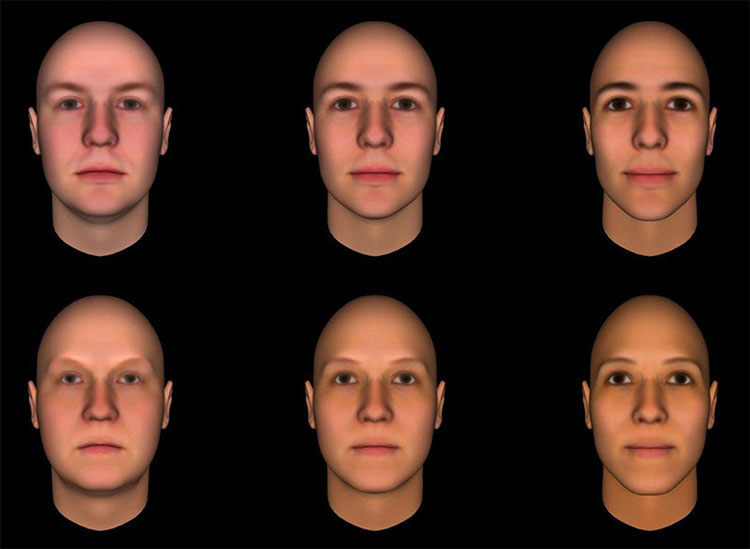Mechanism to assess the personality of others
We give quick assessments of other people's personalities not only based on their facial appearance, but also on our available beliefs about what the personality represents.
The face creates an impression of personality
The research results published in the Proceedings of the National Academy of Sciences (PNAS) explain how we look at other people's facial features to create an impression of their personality.
'We form an impression of the character of others through a face appearance in just a few hundred milliseconds , ' said Jonathan Freeman, a member of the team at the Department of Psychology and the Center for Neuroscience Science. New York University (USA), said. 'Our findings show that facial impressions are formed not only by facial features but also by our beliefs about personality.'
For example, the characteristics that make a face look competent or make a face look similar to the facial features make us believe that the ability and friendliness appear in the personality of others.
We often see a face with childish features that is cute and innocent. Meanwhile, people with an angry face are dishonest and unfriendly.
'Although these impressions are highly reliable, they are often quite inaccurate,' Freeman added. 'Some previous research has shown that the first impression of others' faces plays an important role in a series of real situations, from political elections, employment decisions, and conviction. or even dating ".
Other authors of the study include Ryan Stolier at New York University's Department of Psychology, Eric Hehman at McGill University (Canada), Matthias Keller and Mirella Walker at Basel University (Switzerland). The study was supported by the US National Institutes of Health and the US National Science Foundation.

Impressions of other people's personalities through faces formed in less than 1 second.(Photo: Independent).
Mechanism to create an impression of the personality of others
The first impressions of face appearance can affect how we interact and make decisions with others. Therefore, it is important to understand the mechanism behind these impressions to develop techniques to reduce biases based on facial features, which often work out of consciousness.
In a study published in PNAS, scientists conducted a series of experiments to understand the problem. They want to determine how our pre-existing beliefs about the behavior of personality affect how we 'see' it on the faces of others.
First, all 920 volunteers who participated in the experiment showed their level of trust in the different characteristics that occur in the personality of others. For example, they will show their level of trust in their ability and friendliness and expression in others.
Each participant then observed dozens of faces displayed on the computer screen and quickly evaluated those faces for competence and friendliness. This allows researchers to consider whether volunteers think that the faces are capable of being friendly.
In addition, volunteers were asked about a number of other personality traits including: cute, hot-tempered, assertive, thoughtful, devoted, confident, creative, outstanding, self-confident, calm , outward, smart, moderate, nervous, experienced, responsible, self-conscious, sociable, trustworthy, not fun and weird.
Research results confirm what scientists predict. Volunteers believe in any two characteristics, such as their ability and friendliness, to happen together in the personality of others, their impression of two facial features that express their personalities. This is more and more similar. Therefore, facial features used to assess human character may vary depending on our beliefs.
' Personality beliefs affect our impressions of the face . Therefore, people who believe that any set of related personality traits will tend to notice similar characteristics on the faces of others. This explains how humans can create any impression from a face , 'Stolier said.
Most of the personality traits seen from other people's faces may originate from another personality trait, with a few characters playing a leading role.'For example, a face may not be immediately recognized as dedicated. But it looks cute, intelligent and emotional, so the observer can feel this face is dedicated , 'Stolier said.
The results of the study provide an explanation of how people can form many different impressions of others from just a few features that appear on their faces.
'We can only see traits on a face directly suggesting some personality impressions, such as the docile personality of people with child faces. However, the sensory system can take some of these impressions and put them together, so that we see a devoted, thoughtful face, from a cute and obedient face , ' Stolier. identify.
- Can personality affect fertility?
- Myths about personality
- How will our personality change after 50 years?
- Types of characteristic personalities in the world. What personality do you own?
- Signs that you are a personality disorder
- Read your personality personality through a Japanese test
- Personality can affect health
- Is personality more important than intelligence?
- Elephants also have personality like humans
- Personality can change when weight increases
- See the signature right away if you are a sufferer
- Guess your personality through the artwork you like best
 'Fine laughs' - Scary and painful torture in ancient times
'Fine laughs' - Scary and painful torture in ancient times The sequence of numbers 142857 of the Egyptian pyramids is known as the strangest number in the world - Why?
The sequence of numbers 142857 of the Egyptian pyramids is known as the strangest number in the world - Why? History of the iron
History of the iron What is alum?
What is alum?